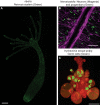Cnidofest 2022: hot topics in cnidarian research
- PMID: 37620964
- PMCID: PMC10463417
- DOI: 10.1186/s13227-023-00217-9
Cnidofest 2022: hot topics in cnidarian research
Abstract
The second annual Cnidarian Model Systems Meeting, aka "Cnidofest", took place in Davis, California from 7 to 10th of September, 2022. The meeting brought together scientists using cnidarians to study molecular and cellular biology, development and regeneration, evo-devo, neurobiology, symbiosis, physiology, and comparative genomics. The diversity of topics and species represented in presentations highlighted the importance and versatility of cnidarians in addressing a wide variety of biological questions. In keeping with the spirit of the first meeting (and its predecessor, Hydroidfest), almost 75% of oral presentations were given by early career researchers (i.e., graduate students and postdocs). In this review, we present research highlights from the meeting.
Keywords: Clytia; Cnidarians; Cnidofest; Conference; Hydra; Hydractinia; Nematostella.
© 2023. BioMed Central Ltd., part of Springer Nature.
Conflict of interest statement
Not applicable.
Figures


References
-
- Browne EN. The production of new hydranths in Hydra by the insertion of small grafts. J Exp Zool. 1909;7(1):1–23. doi: 10.1002/jez.1400070102. - DOI

